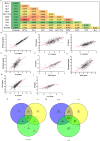Defining the Blood Cytokine Profile in Asthma to Understand Asthma Heterogeneity
- PMID: 40105091
- PMCID: PMC11920881
- DOI: 10.1002/iid3.70116
Defining the Blood Cytokine Profile in Asthma to Understand Asthma Heterogeneity
Abstract
Background: Asthma is a heterogeneous disease characterized by overlapping clinical and inflammatory features.
Objective: This study aimed to provide insight into the systemic inflammatory profile in asthma, greater understanding of asthma endotypes and the contribution of genetic risk factors to both.
Methods: 4205 patients with asthma aged 16-60 were recruited from UK centers; serum cytokines were quantified from 708, including cytokines associated with Type 1, 2 and 17 inflammation. 3037 patients were genotyped for 25 single nucleotide polymorphisms associated with moderate-severe asthma.
Results: Serum cytokines associated with Th2 inflammation showed high coordinated expression for example, IL-4/IL-5 (R2 = 0.513). The upper quartile of the serum cytokine data identified 43.7% of patients had high levels for multiple Th2 cytokines. However, the groups defined by serum cytokine profile were not clinically different. Childhood-onset asthma was characterized by elevated total IgE, allergic rhinitis and dermatitis. Exacerbation prone patients had a higher BMI, smoking pack-years, asthma control questionnaire score and reduced lung function. Patients with blood eosinophils of > 300 cells/µL had elevated total IgE and lower smoking pack-years. None of these groups had a differential serum cytokine profile. Asthma risk alleles for; rs61816764 (FLG) and rs9303277 (IKFZ3) were associated with childhood onset disease (p = 2.67 × 10- 4 and 2.20 × 10- 7; retrospectively). No genetic variant was associated with cytokine levels.
Conclusion: Systemic inflammation in asthma is complex. Patients had multiple overlapping inflammatory profiles suggesting several disease mechanisms. Genetic risk factors for moderate-severe asthma confirmed previous associations with childhood onset of asthma.
Keywords: asthma; blood cytokines; endotypes; genetics.
© 2025 The Author(s). Immunity, Inflammation and Disease published by John Wiley & Sons Ltd.
Conflict of interest statement
The authors declare no conflicts of interest.
Figures


Similar articles
-
Transcriptomic Profiles in Nasal Epithelium and Asthma Endotypes in Youth.JAMA. 2025 Jan 28;333(4):307-318. doi: 10.1001/jama.2024.22684. JAMA. 2025. PMID: 39745770 Free PMC article.
-
Anti-interleukin-13 and anti-interleukin-4 agents versus placebo, anti-interleukin-5 or anti-immunoglobulin-E agents, for people with asthma.Cochrane Database Syst Rev. 2021 Oct 19;10(10):CD012929. doi: 10.1002/14651858.CD012929.pub2. Cochrane Database Syst Rev. 2021. PMID: 34664263 Free PMC article.
-
[Guidelines for the prevention and management of bronchial asthma (2024 edition)].Zhonghua Jie He He Hu Xi Za Zhi. 2025 Mar 12;48(3):208-248. doi: 10.3760/cma.j.cn112147-20241013-00601. Zhonghua Jie He He Hu Xi Za Zhi. 2025. PMID: 40050074 Chinese.
-
Omalizumab for asthma in adults and children.Cochrane Database Syst Rev. 2014 Jan 13;2014(1):CD003559. doi: 10.1002/14651858.CD003559.pub4. Cochrane Database Syst Rev. 2014. PMID: 24414989 Free PMC article.
-
Inflammatory and clinical risk factors for asthma attacks (ORACLE2): a patient-level meta-analysis of control groups of 22 randomised trials.Lancet Respir Med. 2025 Jun;13(6):505-516. doi: 10.1016/S2213-2600(25)00037-2. Epub 2025 Apr 8. Lancet Respir Med. 2025. PMID: 40215991 Free PMC article.
References
-
- Lötvall J., Akdis C. A., Bacharier L. B., et al., “Asthma Endotypes: A New Approach to Classification of Disease Entities Within the Asthma Syndrome,” Journal of Allergy and Clinical Immunology 127, no. 2 (2011): 355–360. - PubMed
Publication types
MeSH terms
Substances
Grants and funding
LinkOut - more resources
Full Text Sources
Medical
Miscellaneous

